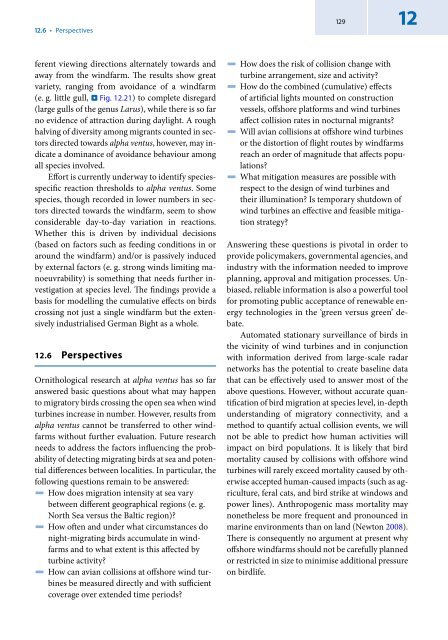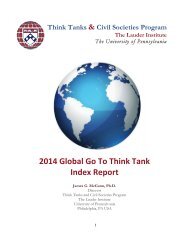bok%3A978-3-658-02462-8.pdf?auth66=1398409209_a0514c2b8e531c058ab8b810a0cad74d&ext=
bok%3A978-3-658-02462-8.pdf?auth66=1398409209_a0514c2b8e531c058ab8b810a0cad74d&ext=
bok%3A978-3-658-02462-8.pdf?auth66=1398409209_a0514c2b8e531c058ab8b810a0cad74d&ext=
- No tags were found...
Create successful ePaper yourself
Turn your PDF publications into a flip-book with our unique Google optimized e-Paper software.
12.6 • Perspectivesferent viewing directions alternately towards andaway from the windfarm. The results show greatvariety, ranging from avoidance of a windfarm(e. g. little gull, . Fig. 12.21) to complete disregard(large gulls of the genus Larus), while there is so farno evidence of attraction during daylight. A roughhalving of diversity among migrants counted in sectorsdirected towards alpha ventus, however, may indicatea dominance of avoidance behaviour amongall species involved.Effort is currently underway to identify speciesspecificreaction thresholds to alpha ventus. Somespecies, though recorded in lower numbers in sectorsdirected towards the windfarm, seem to showconsiderable day-to-day variation in reactions.Whether this is driven by individual decisions(based on factors such as feeding conditions in oraround the windfarm) and/or is passively inducedby external factors (e. g. strong winds limiting manoeuvrability)is something that needs further investigationat species level. The findings provide abasis for modelling the cumulative effects on birdscrossing not just a single windfarm but the extensivelyindustrialised German Bight as a whole.12.6 PerspectivesOrnithological research at alpha ventus has so faranswered basic questions about what may happento migratory birds crossing the open sea when windturbines increase in number. However, results fromalpha ventus cannot be transferred to other windfarmswithout further evaluation. Future researchneeds to address the factors influencing the probabilityof detecting migrating birds at sea and potentialdifferences between localities. In particular, the-following questions remain to be answered:How does migration intensity at sea varybetween different geographical regions (e. g.-North Sea versus the Baltic region)?How often and under what circumstances donight-migrating birds accumulate in windfarmsand to what extent is this affected by-turbine activity?How can avian collisions at offshore wind turbinesbe measured directly and with sufficientcoverage over extended time periods?129 12How does the risk of collision change with-turbine arrangement, size and activity?How do the combined (cumulative) effectsof artificial lights mounted on constructionvessels, offshore platforms and wind turbines-affect collision rates in nocturnal migrants?Will avian collisions at offshore wind turbinesor the distortion of flight routes by windfarmsreach an order of magnitude that affects populations?-What mitigation measures are possible withrespect to the design of wind turbines andtheir illumination? Is temporary shutdown ofwind turbines an effective and feasible mitigationstrategy?Answering these questions is pivotal in order toprovide policymakers, governmental agencies, andindustry with the information needed to improveplanning, approval and mitigation processes. Unbiased,reliable information is also a powerful toolfor promoting public acceptance of renewable energytechnologies in the ‘green versus green’ debate.Automated stationary surveillance of birds inthe vicinity of wind turbines and in conjunctionwith information derived from large-scale radarnetworks has the potential to create baseline datathat can be effectively used to answer most of theabove questions. However, without accurate quantificationof bird migration at species level, in-depthunderstanding of migratory connectivity, and amethod to quantify actual collision events, we willnot be able to predict how human activities willimpact on bird populations. It is likely that birdmortality caused by collisions with offshore windturbines will rarely exceed mortality caused by otherwiseaccepted human-caused impacts (such as agriculture,feral cats, and bird strike at windows andpower lines). Anthropogenic mass mortality maynonetheless be more frequent and pronounced inmarine environments than on land (Newton 2008).There is consequently no argument at present whyoffshore windfarms should not be carefully plannedor restricted in size to minimise additional pressureon birdlife.




